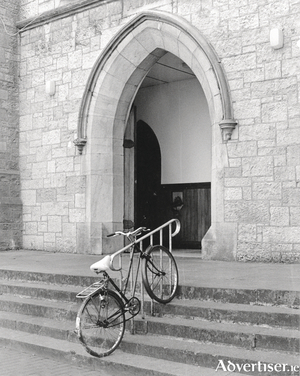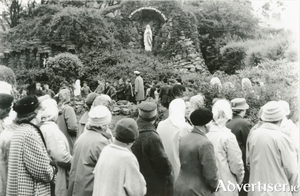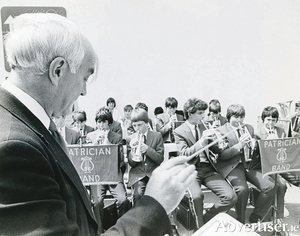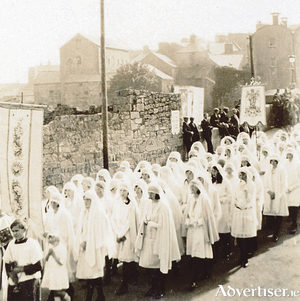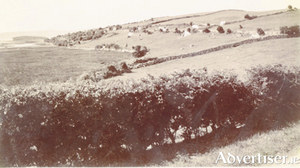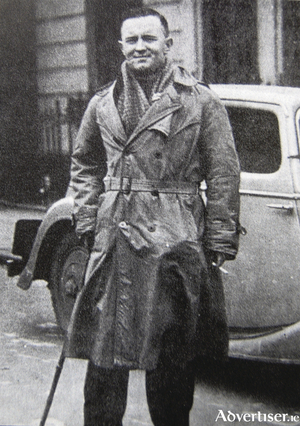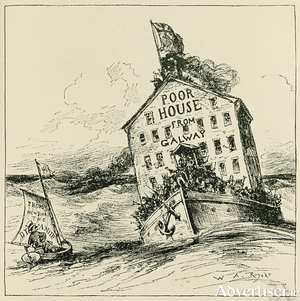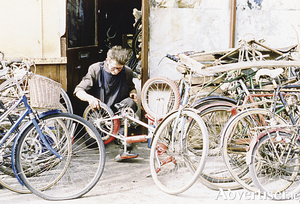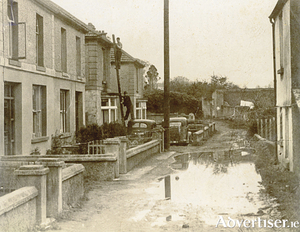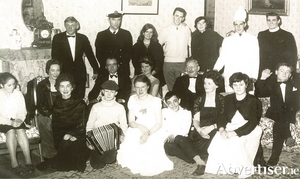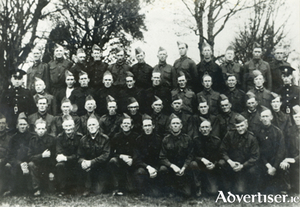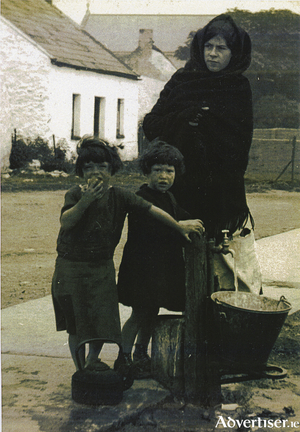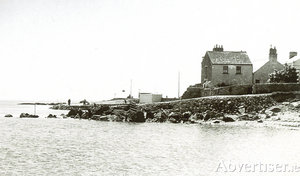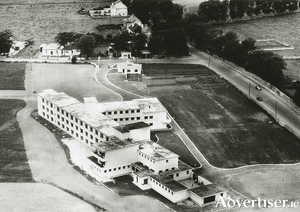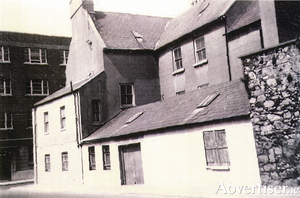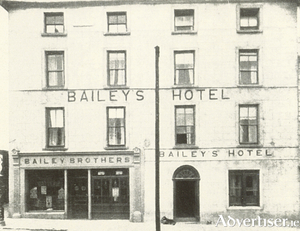The Galway Augustinians
Thu, May 25, 2017
These are probably the best known and best worn set of steps in Galway. They were built in the 1855 - 59 period while the present Augustinian Church was being constructed. The site was slightly higher than the road level so the steps were required at the front and the back of the church. The Augustinian connection with the city goes much further back than that.
Read more ...The Grotto of Our Lady of Lourdes
Thu, May 18, 2017
A grotto is a natural or artificial cave used by humans in modern times and antiquity. Today, they are often used as shrines in which to place statues of saints, particularly the Virgin Mary. The Grotto of Our Lady of Lourdes stood in the southwest corner of the grounds of St Patrick’s Church.
Read more ...Shangort, Knocknacarra
Thu, May 11, 2017
This photograph of the Shangort area of Knocknacarra was originally taken in the 1950s by Aodh MacDúbháin, a teacher in St Enda’s who did a lot of work with An Taidhbhearc. It was taken from Carragh Hill.
Read more ...The Patrician Boys’ Brass Band
Thu, May 04, 2017
When you think of it, the Patrician Brothers have made a major impact on the city of Galway since they came here. This has been particularly evident in the music world of the city — they set up a fife and drum band well over a century ago; they have trained countless choirs down through the years, which in turn led to the formation of the Patrician Musical Society; they have formed many céilí bands, teaching the boys to play the accordion, the flageolet, the mouth organ, the triangle, the drums, and castanets. There was such a demand for these céilí groups at civic functions that the brothers decided to put their best foot forward and form a brass band.
Read more ...The Corpus Christi procession
Thu, Apr 27, 2017
“Upwards of seven thousand people took part in the annual Eucharistic Procession through the streets of Galway on Sunday, when one of the greatest demonstrations of faith in recent years was seen. Practically all of that part of the city’s population which did not take part, thronged the footpaths, and when the procession arrived at Eyre Square at six o’clock, upwards of ten thousand people knelt on the green sward in front of the specially constructed high altar for the final Benediction, which was imparted by his Lordship, Most Rev Dr Browne.
Read more ...Gentian Hill
Thu, Apr 20, 2017
The correct name for this promontory is Blake’s Hill which comprises approximately 30 acres. Gentian Hill was a much smaller area further north, but nowadays the whole area is referred to as Gentian Hill. An extract from O’Donovan’s Letters described it as follows: “Here in Blake’s Hill over the sea, whither the young men of Galway were wont to come on horseback on the third day of their May game, and there dine between the hill and the castle of Barna. Sir Moragh O’Flaherty of Aughamore defeated an army out of Clanricard on the 22nd of June 1564 on the strand at Traybane, Cnoc an Blacaigh.”
Read more ...Lord Haw-Haw, the early years
Thu, Apr 13, 2017
In 1915, a short, fair-haired, blue-eyed, boy was sent to the Jes. He later recalled the staff and the pupils as being tough. Latin was supreme and an excitable Latin teacher banged boys’ heads on the radiator. The Jesuits instilled in him a sense of discipline and an acceptance of punishment, and they left him with a love of language — his classmates would note how he used big and strange words — as well as a passion for debate. His uncle Gilbert once remarked, “The boy had a strong tendency to argue with his teachers.”
Read more ...Poorhouse from Galway
Thu, Apr 06, 2017
“With giant strides destitution and misery progress — the wants of the people daily and hourly progress — the cries for succour and assistance go forth, and ere long, even now, the distress of the poor has attained a degree fearful to contemplate. Turn to what quarter we may, the same dismal tale is told to us — in every direction we see countenance wan with care and hunger. In a like condition are the inhabitants of the rural districts, and we find that parishes — Annadown for instance, which used to supply the markets of Galway so abundantly, after supporting its own people in comfort, are now reduced to a most pitiable condition. There indeed, some of the landlords, at least those who reside at home, have stepped forward seasonably to the relief of their fellow creatures, and headed by the Cregg family, ever remarkable for their benevolence, seem resolved to do their duty.”
Read more ...Michael Newell, The ‘Bicycle Man’
Thu, Mar 30, 2017
Michael Newell was born near Headford, and went to school in Roscrea where he played rugby for the school. He emigrated to New Zealand for a while before returning to Galway to take over a premises on Sea Road that had been occupied by Dan Whyte the barber, and his daughter Rita, who taught Irish dancing there. He set up an ice cream parlour that became a great haunt for local teenagers. He made his own ice cream and ice pops but the biggest attraction was the novel (for the time) milk shakes that he made, and then topped them off with strawberries or raspberries or some other fruit. “It was almost impossible to look in the window without feeling a huge need for an ice cream.” He would roll up a piece of paper into the shape of a cone, put a twist on the end of it and pop a measured number of bulls eyes into it, a process which always fascinated the children. He was ahead of his time but he was not really a businessman.
Read more ...Old Devon Park
Thu, Mar 23, 2017
The area we know today as Devon Park was originally part of the O’Hara Estate which was the land around Lenaboy Castle (now St Anne’s on Taylor’s Hill). The main gates to this estate were, and are, next door to the Warwick Hotel. Part of the estate wall ran along the main Salthill road.
Read more ...The D&I Dramatic Society
Thu, Mar 16, 2017
The Dominican and Ignatian Dramatic Society (known as the D&I) was set up by Fr Peadar Feeney SJ in the late 1950s. Most of the members were past pupils of St Ignatius’ College or The Dominican Convent, Taylor’s Hill. They staged a play every year for several years with any profits accruing going to the two school funds.
Read more ...Claregalway heroes
Thu, Mar 09, 2017
In the years following the establishment of the Defence Forces, various classes of Army Reserves were experimented with between 1927 and 1939. In May 1927, a Class A Reserve was formed consisting of NCOs and men transferred to the Reserve. In January 1928, a Class B Reserve was set up with the object of building up the infantry arm of the Defence Forces. One joined voluntarily, but in doing so, committed to three months initial training and one month’s annual training thereafter. This group had practically ceased to exist by 1934.
Read more ...The Church of St James, Barna
Thu, Mar 02, 2017
The first church in the Barna area that we know of was a small stone building with a thatched roof on the right of the road down to Silver Strand, just opposite the entrance to Tobar Éanna. You can still see some of the remains there. It was in use until December 1839. On June 4, 200 adults were confirmed by Bishop Browne there.
The church in our photograph was named after St James and was built in 1830s on the main Barna Road. The first Mass there was celebrated on January 5, 1840. It was a T-shaped structure, rather than cruciform, with a small sacristy attached to the top of the T. It was easier to construct and the sacristy was placed behind the sanctuary. It was typical of churches built after Catholic Emancipation and it was paid for and built by the local landlords, the Lynch family from Barna House. There was a gallery level in the east end of the nave which was reached by a timber stairs. This and the entrance porch and floor were additions to the original basic church. In a number of similar churches there was a room either over or under the sacristy where the priest actually lived.
Read more ...The Galway Gas Company
Thu, Feb 23, 2017
The Galway Board of the Town Commissioners was established in the early 1830s and one of its first objectives was the provision of gas lighting in the city. In December 1836, the commissioners invited a Mr Lyddle from Glasgow to do a survey of the town and he recommended the establishment of a Galway Gas Company. His advice was taken. Shares were snapped up, an agreement was reached between the company and the town commission, and the Rev D’Arcy was appointed company secretary.
Read more ...Hardiman’s description of The Claddagh
Thu, Feb 16, 2017
“The only occupation is fishing; they never trouble themselves with tillage; a milch cow and a potatoe garden are rare among them ------, then on shore they are principally employed in attending to, and repairing their boats, sails, rigging, cordage etc .., and in making, drying or repairing their nets and spillets, in which latter employment they are generally assisted by the women who spin hemp and yarn for the nets ....
Read more ...One hundred and seventy five years of Mercy education in Galway
Thu, Feb 09, 2017
The Sisters of Mercy came to Galway on May 1 1840. They started, in extremely difficult circumstances, in Lombard Street with three postulants. The need for uncloistered sisters who would be free to go about the streets and visit the poor in home, hospital, and jail was very great at the time. They were out and about the day after their arrival. An epidemic of cholera had broken out and they helped to nurse the ill and alleviate distress. They quickly prospered to become “Reputedly the best institution that ever was in Galway”.
Read more ...The Lazy Wall
Thu, Feb 02, 2017
This photograph was taken looking west from where Seapoint is today. The house in the picture was roughly across the street from the Bon Bon. It was once an RIC barracks and was latterly occupied by Monica Wallace. There was a concrete bench along the wall in front of the house, which was known as “The Lazy Wall”, a place where old and countrified people, known as “The Fámairí”, would relax and chat and gossip. They came not for the views but for the conversations. Many arrived after their crops had been harvested. They usually brought their own food in the form of home-cured bacon, fresh eggs, butter, cooked chickens, and cakes of bread. “You rented a room and you ate yourself.” They would use the family kitchen of the house in which they were staying and consider themselves part of that family for the duration. There was a small bit of beach below the wall where the patrons could bathe or paddle.
Read more ...Galvia/Calvary Hospital
Thu, Jan 26, 2017
An interesting number of medical institutions were established in Galway in the 20th century. In 1908 the Port Sanitary Intercepting Hospital was built near the docks opposite Forthill Cemetery as quarantine for any suspected cases of cholera or smallpox that might have come in on board ship. It cost £1,000, had 20 beds, and happily it was never needed for its primary purpose and only ever housed three patients. It burnt down in 1966.
Read more ...Máirtín Mór
Thu, Jan 19, 2017
This photograph of the corner of New Dock Street and Flood Street dates from the 1930s. The large three-storey house on Flood Street was formerly known as ‘The Dispensary’ and was the property of the Poor Law Guardians. It was obviously occupied by a doctor. It was in this house that the McDonogh dynasty began in Galway.
Read more ...Bailey’s Hotel, Eyre Square
Thu, Jan 12, 2017
When Bailey’s Hotel was being sold it was advertised as being “Fifty Yards from the Railway Station. One hundred and fifty yards from the docks. Frontage; Fifty Feet. Depth: one hundred feet. Eigheen bedrooms, four reception rooms. One additional large room sixty feet by twenty six feet. Bath rooms, lavatories, Kitchen, Pantry, Yard etc. Electric light throughout. Very fine bar, seven day licence. Premises held under lease of 99 years from March 1904, at yearly rent of £4.”
Read more ...